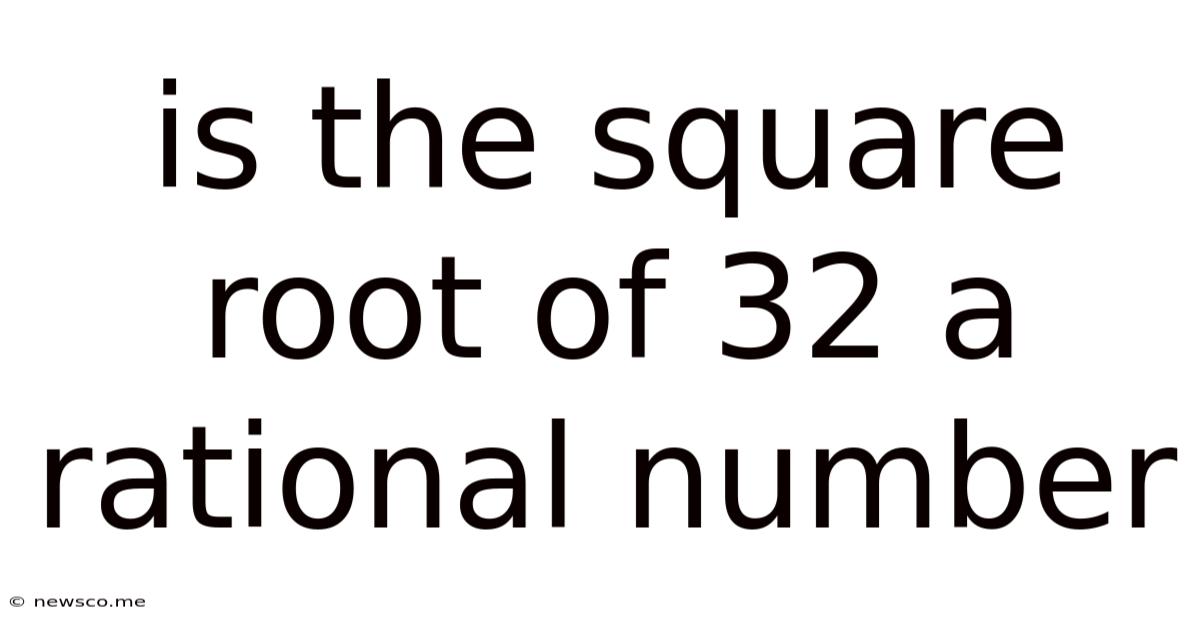Is The Square Root Of 32 A Rational Number
News Co
May 07, 2025 · 4 min read

Table of Contents
Is the Square Root of 32 a Rational Number? A Deep Dive into Irrationality
The question of whether the square root of 32 is a rational number is a fundamental concept in mathematics, touching upon the core distinctions between rational and irrational numbers. Understanding this requires a solid grasp of number theory and the properties of square roots. This article will delve into the intricacies of this question, providing a comprehensive explanation accessible to both beginners and those seeking a deeper understanding.
Understanding Rational and Irrational Numbers
Before we tackle the square root of 32, let's establish a firm foundation. Rational numbers are numbers that can be expressed as a fraction p/q, where p and q are integers, and q is not zero. Examples include 1/2, 3/4, -5/7, and even integers like 4 (which can be written as 4/1).
Irrational numbers, on the other hand, cannot be expressed as a simple fraction. Their decimal representations are non-terminating and non-repeating. Famous examples include π (pi), e (Euler's number), and the square root of 2 (√2).
Exploring the Square Root of 32
Now, let's focus on the square root of 32 (√32). To determine if it's rational or irrational, we need to investigate if it can be expressed as a fraction p/q. We can begin by simplifying the radical:
√32 = √(16 * 2) = √16 * √2 = 4√2
This simplification reveals a crucial element: the square root of 32 is a multiple of the square root of 2. Since we know that √2 is irrational (a fact proven by contradiction, a method we'll explore later), multiplying it by a rational number (4) does not change its fundamental nature. The product of a rational number and an irrational number is always irrational.
Proof by Contradiction: The Irrationality of √2
To definitively establish the irrationality of √32, we need to solidify the understanding that √2 is irrational. This is typically demonstrated using a classic proof by contradiction:
-
Assumption: Let's assume, for the sake of contradiction, that √2 is rational. This means it can be expressed as a fraction p/q, where p and q are integers, q ≠ 0, and the fraction is in its simplest form (meaning p and q share no common factors other than 1).
-
Squaring Both Sides: If √2 = p/q, then squaring both sides gives us 2 = p²/q².
-
Rearrangement: This can be rearranged to 2q² = p². This equation tells us that p² is an even number (since it's equal to 2 times another integer).
-
Implication for p: If p² is even, then p itself must also be even. This is because the square of an odd number is always odd. Since p is even, we can express it as p = 2k, where k is another integer.
-
Substitution and Simplification: Substituting p = 2k into the equation 2q² = p², we get 2q² = (2k)² = 4k².
-
Further Simplification: Dividing both sides by 2, we obtain q² = 2k². This shows that q² is also an even number, and therefore q must be even as well.
-
Contradiction: We've now shown that both p and q are even numbers. This contradicts our initial assumption that p/q is in its simplest form (because they share a common factor of 2).
-
Conclusion: Since our initial assumption leads to a contradiction, the assumption must be false. Therefore, √2 is irrational.
Extending the Proof to √32
Because we've proven √2 is irrational, and √32 simplifies to 4√2, we can confidently conclude that √32 is also irrational. Multiplying an irrational number (√2) by a rational number (4) does not transform it into a rational number.
Further Exploration: Decimal Representation
The decimal representation of √32 is approximately 5.656854249... This decimal representation is non-terminating and non-repeating, further supporting the conclusion that √32 is irrational. Rational numbers either have a terminating decimal representation (like 0.5 or 0.75) or a repeating decimal representation (like 1/3 = 0.333...). The non-repeating, non-terminating nature of √32's decimal expansion aligns perfectly with the characteristics of irrational numbers.
Practical Implications and Real-World Applications
While the concept of irrational numbers might seem purely theoretical, they have significant practical implications. Irrational numbers frequently appear in various fields, including:
-
Geometry: Calculations involving circles, spheres, and other curved shapes often involve π, an irrational number.
-
Physics: Many physical constants, such as the speed of light and Planck's constant, are irrational numbers.
-
Engineering: The precise calculations required in engineering designs often necessitate the use of irrational numbers to ensure accuracy.
-
Computer Science: Representing and working with irrational numbers in computer programs requires careful consideration of approximation methods.
Conclusion: The Irrationality of √32 Confirmed
Through a combination of simplification, proof by contradiction, and an understanding of the properties of rational and irrational numbers, we have definitively established that the square root of 32 is irrational. This understanding is crucial not only for theoretical mathematics but also for various practical applications across numerous disciplines. The non-terminating and non-repeating decimal expansion further solidifies this conclusion. The concept underscores the rich and complex nature of the number system and highlights the importance of rigorous mathematical reasoning.
Latest Posts
Related Post
Thank you for visiting our website which covers about Is The Square Root Of 32 A Rational Number . We hope the information provided has been useful to you. Feel free to contact us if you have any questions or need further assistance. See you next time and don't miss to bookmark.